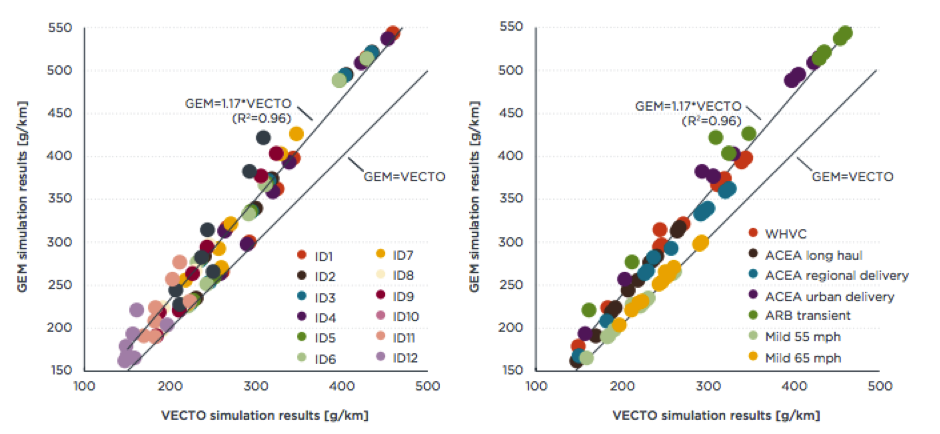Blog
Truckin’.exe: Using computer simulations to certify the fuel efficiency of trucks
A couple of months ago we published a paper looking at differences in efficiency between EU, US, and Chinese trucks, and we theorized that the adoption of efficiency technologies is likely slower in the absence of efficiency/CO2 standards. (We also tried to establish that custom-painted flame graphics bear no relation to peak torque, but that was finally taken out after peer-review due to a lack of consensus.) Such standards are sorely lacking in the EU, which is lagging behind the US in the implementation of HDV efficiency regulations. To make matters worse, US trucks (with their massive grilles and top-mounted exhaust pipes) also look much cooler (I believe this is the correct scientific term) than the snub-nosed camions that we get in Europe (by the way, there’s a reason for those short cabins, and it’s not related to efficiency).
Following this line of work that compares HDV fleets and regulations across regions, this time we present some research comparing the US and the EU approaches on the rather specific topic of whole-vehicle simulation of heavy-duty vehicle efficiency. We recently released a white paper that explores the differences between the software tools used to simulate heavy-duty vehicle CO2 emissions and fuel consumption in the EU (VECTO 2.0.3, in beta and not yet publicly distributed) and the US (GEM 2.0, already use as part of US Phase 1 regulations). These tools are developed by regulators for the certification of the CO2 emissions/fuel efficiency of trucks. We view this white paper as an opportunity to start a dialogue within the regulatory and scientific community about the role of simulation in HDV regulations, and to identify opportunities for alignment and harmonization across different regions. Mind you, this is not always an apples-to-apples comparison, but we found that both simulation models performed as they were intended, and that they provide comparable results provided that the relevant input parameters are aligned (Figure 1).

Figure 1. We simulated 12 vehicles over 7 duty cycles with both GEM and VECTO. Zero hands got greasy in the process.
In our view, whole-vehicle HDV efficiency simulation makes a lot of technical and economic sense. Truck manufacturers know this, and they have long been using computer simulations for vehicle development purposes. HDV efficiency simulation tools are based on well-known physical principles, and they work rather well provided that the necessary input parameters that characterize a few key components (engine, transmission, tires, payloads, etc.) are available. Once that condition is met, simulation technology can really shine: it allows the user of the simulation model to study the influence that individual parameters (and the interactions among them) have upon fuel consumption. Most importantly, a large number of simulation runs can be performed with minimal marginal cost, which is an important advantage for regulators and vehicle and component manufacturers having to deal with the certification of hundreds of different possible combinations of tractor bodies and trailers, engines and transmissions. Whole-vehicle simulation techniques have the potential to reduce vehicle testing efforts worldwide, as well as to improve the quality and availability of much-needed HDV efficiency data. This could be accomplished by placing the regulatory focus more on individual component testing and modeling to feed the simulation tools rather than on whole-vehicle measurements at the dynamometer test bench.
The simulation tools used in regulatory environments are simpler than the proprietary tools that OEMs have been using for development, but they are being further developed (sometimes in collaboration with OEMs) to include more technologies with fuel-saving potential (e.g., advanced transmissions or intelligent management of auxiliaries). Our colleagues at EPA (who are working on a new version of GEM as we write this) and the European Commission’s Joint Research Centre know very well about this. The final equilibrium point between simplicity and comprehensiveness is still uncertain: regulators favor transparency and simplicity (because they want to make sure they control the operation of their tools), but OEMs require more sophisticated models to be able to demonstrate the benefits of advanced control systems and powertrain configurations (for example hybrid vehicles, which are not fully covered by simple models such as GEM or VECTO).
Also, China, the EU and the US are developing their own tools even though a global, harmonized tool for HDV efficiency simulations would highly desirable, because it would improve the quality and comparability of data and reduce costs for both regulators and manufacturers. All in all, the hurdles to harmonization are less technical than they are political and administrative—intellectual property rights, data ownership and confidentiality issues. A stepping stone to a full globally harmonized tool would be for countries to align their tools around a set of mutually agreed upon best practices.
For now, VECTO and GEM will continue to be developed independently, European regulators will keep on dithering about HDV CO2 standards, and the relationship of flame graphics to peak torque will remain a subject of tantalizing speculation.
